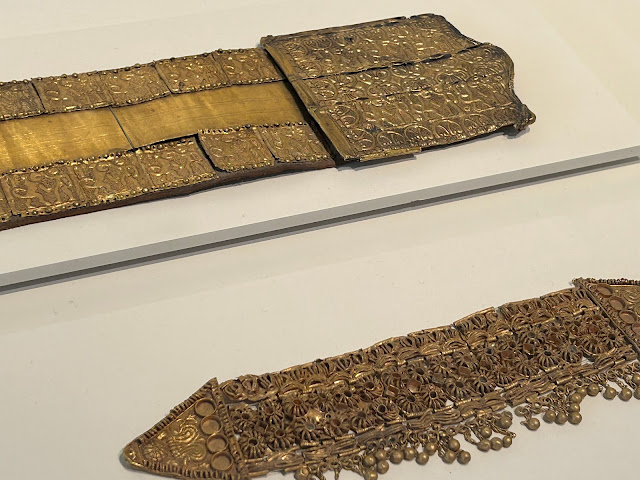The Bronze age in Iberia was from 2200 to 1300 BCE. Cultural diversity begins to be more apparent and easier to identify for modern archeologists. It is also the time where differences in economic status become more pronounced.
Pots from cultures of the Bronze age. An example of walled towns are depicted behind them.
Gold plaques make up this belt showing the god-hero Melqart fighting creatures real and imagined.
Using sheet silver a patera for drinking was made. Wolfs eating a human head while serpents surround both have been uncovered in the Iberian peninsula. What makes this item unique is the Hellenistic centaurs at a banquet holding instruments. This is most likely because of the interaction between Iberians and the Phoenician and Greek trading ports and colonies here.
Indicating the prominence of women in early Iberian cultures, the Lady of Baza statue has symbols of divinity and that of a spiritual intermediary.
The Lady of Elche has similar symbols as the Lady of Baza.
Pendants of heads made in the 4th to 3rd centuries BCE. They look interesting but odd and I would love to know more about them.
There was a culture on the Canary islands before taken over by the Spanish made up from ancestors of the Berbers. It is postulated that the Phoenicians, Greeks, and Carthaginians most likely visited there. King Juba the second is credited as being the first to claim and record its discovery and various European sailors made small colonies here. The Castilian Spanish in 1402 made a full invasion and brutalized the population here which lasted for over a century and led to enslavement for its indigenous population for growing and harvesting sugar. The mummified remains below was found in a cave in 1764 and is from the 12th to 13th centuries.
From the late bronze age, this gold bowl or hat is from the Tumulus or Urnfield cultures. There are solar symbols on it, probably for religious events.
A Greek urn from the workshops in the Colony ports in Iberia.
A diadem from the third century BCE, found in the La Puebla de los Infantes horde.












No comments:
Post a Comment